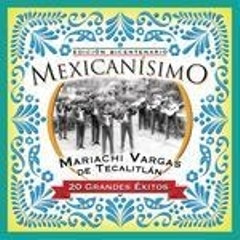Mariachi Vargas De Tecalitlan – Mexicanisimo Bicentenario (2010)
Mariachi Vargas De Tecalitlan – Mexicanisimo Bicentenario (2010)

01. Las Mananitas (03:21) play 02. En Tu Dia (02:58) 03. La Negra (02:11) 04. Guadalajara (04:38) 05. Jarabe Tapatio (03:38) 06. La Culebra (02:49) 07. Las Alazanas (04:01) 08. El Pasajero (02:37) 09. Los Arrieros (03:20) 10. Camino Real de Colima (02:35) 11. El Tirador (02:58) play 12. Las Olas (02:55) 13. El Cuatro (02:55) 14. El Carretero (03:23) 15. El Cascabel (03:30) 16. La Bikina (03:34) 17. Poeta y Campesino (05:13) 18. Mexico de Noche (Noche a Noche) (02:36) 19. Sabes una Cosa (03:11) 20. Las Golondrinas (03:19)
Mariachi Vargas de Tecalitlan is a Mexican folk ensemble of mariachi music created in 1897 by Gaspar Vargas. From 1950 it has been under the artistic guidance of the Rubén Fuentes. The group's musical direction has been the responsibility of Don Jose "Pepe" Martinez since 1975.
Members: A minimum mariachi group has 2 violins, 2 trumpets, 1 guitarrón, 1 guitar, and 1 vihuela. Complete mariachi groups have a minimum of 12 members with the standard 6 violins, 3 trumpets, 1 guitarrón, 1 guitar and 1 vihuela. A 13th member is often a harp, an extra violin, or an extra guitar. The Vargas de Tecalitlán currently has thirteen members, distributed as follows. Violins: Steeven Sandoval, Alberto Alfaro, Jose "Pepe" Martinez (Director), Jose Martinez Jr., Daniel Martinez, and Andres Gonzalez Trumpets: Federico Torres (member since 1966), Gustavo Alvarado (since 1991), and Fernando Valasquez (since 2007) Guitarrón: Enrique de Santiago (member of the group since 1989) Guitar: Arturo Vargas (member of the group since 2003 and originating in Jalisco) Vihuela: Miguel Angel Barron (part of the group since 2011, being the newest member of Mariachi Vargas de Tecalitlan) Harp: Julio Martínez
The history of Mariachi Vargas de Tecalitlan is divided into five phases (or generations); the first generation from 1897 to 1930, the second from 1931 to 1949, the third from 1950 to 1993, the fourth from 1994 to 2002 and the fifth since 2003 to date.
From 1937 until now (2009), the Mariachi Vargas has produced over 50 recordings, whose contents are Huastecos sones, waltzes, popurris, polkas, huapango, cumbias, among others.
El Mariachi Vargas de Tecalitlán es una agrupación de música mexicana creada en 1898 por el maestro Gaspar Vargas López (1880-1969),1 y que se encuentra bajo la producción artística del maestro Rubén Fuentes; al mismo tiempo, la dirección musical del grupo está a cargo de Don José "Pepe" Martínez. La agrupación está conformada por un arpa, una vihuela, una guitarra, un guitarrón, tres trompetas y seís violines, y en el mundo son concidos con el título de El Mejor Mariachi del Mundo, nombre que el propio maestro Fuentes, como director artístico de RCA, sugirió para el grupo.
El número total de integrantes que conforman el grupo son 13 distribuidos de la siguiente manera: Arpa: Julio Martínez Guitarra: Arturo Vargas (desde 2003). Guitarrón: Enrique Santiago (desde 1989). Vihuela: Miguel Ángel Barrón (desde 2011). Trompetas: Federico Torres (miembro desde 1966), Gustavo Alvarado y Luis Fernando Velásquez (desde 2008). Violines: Steven Sandoval, Alberto Alfaro, José "Pepe" Martínez (Director musical del grupo), José Martinez Jr., Daniel Martínez y Andrés González (desde 2007).
El 14 de Enero de 2011 se anunció el retiro de Víctor Cárdenas (Vihuela). En su juventud tocó en la Plaza Garibaldi (México D.F.) hasta que fue escogido por Silvestre Vargas y Heriberto "El Curita" Molina como miembro del Mariachi en 1960. Se ha convertido, a lo largo de este medio siglo en el Vargas en "El rey de la Vihuela" gracias a que creó en este tiempo un estilo único y sonido reflejados en piezas como Violín Huapango. y El Cascabel. En su lugar, el maestro Fuentes escogió como nuevo intérprete de vihuela del grupo al músico Miguel Ángel Barrón, proveniente de Guadalajara.
La historia del mariachi se divide en cinco etapas (o generaciones), siendo la primera generación desde 1898 hasta 1930, la segunda desde 1931 hasta 1949, la tercera desde 1950 hasta 1974, la cuarta desde 1975 hasta 1999, y la quinta desde 2000 hasta la fecha. Desde 1937 hasta ahora (2009), el Mariachi Vargas ha elaborado más de 50 trabajos discográficos, en cuyos contenidos se encuentran sones huastecos, valses, popurris, polkas, huapangos, cumbias, entre otros.
download (mp3 @128 kbs):
yandex 4shared mega mediafire cloudmailru oboom uplea
Last Updated (Friday, 27 November 2015 09:22)








